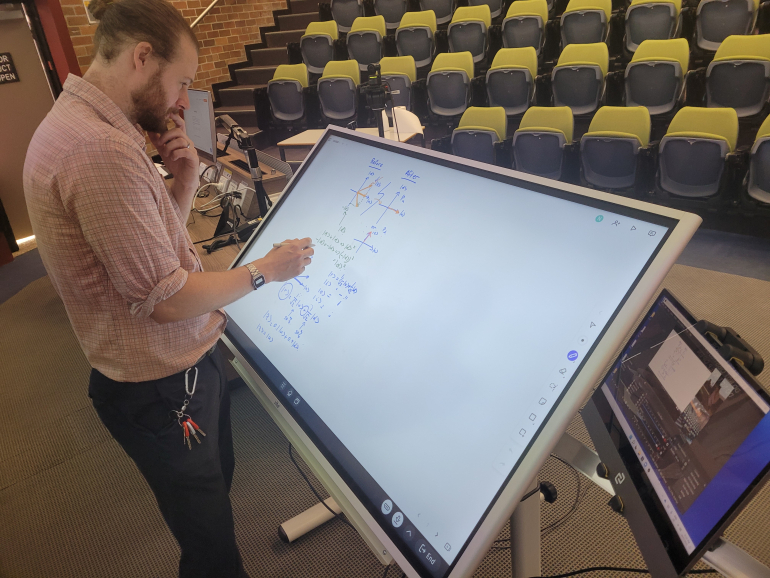By Neil Lawrence | Published 21 March 2022
In the Faculty of Science, a new custom-built 'digital whiteboard' setup has had an incredible academic uptake, with nearly all courses in the School of Physics aiming to use it in some capacity in Term 2. The smartboard and two tracking cameras enable effective hybrid participation and interaction both in class and online.
Too many times over the last few years we have found technology has hindered our teaching. We have needed to change our pedagogy to fit in with the tools that are at hand, or which we have experience or expertise in. In the School of Physics we wanted to reverse this trend - to put educators and students before technology, and have them lead rather than follow.
“I'd argue this is the best set-up available on campus by a country mile, having used it.” - a Physics educator
We achieved this by centring our Digital Teaching Setup around a large writing surface - a 55” smartboard - for educators to easily share their knowledge, and have it displayed on one of the large projectors in the teaching space so there is a clear view for all. Through the smartboard's software, many elements can be brought into the learning environment including a writing canvas, PowerPoint, PDFs, YouTube videos, as well as other apps like Moodle or Echo360.
Instead of the traditional position for teaching, ie. standing in front of the blackboard and turning to interact with students, we placed the board low and angled in front of the educator for better engagement. Now the educator can write and talk in a more natural position facing the students.
The setup is completed with two cameras; a face-tracking webcam to follow the educator around the teaching space, and an audience camera. Together, the two camera feeds and the smartboard screen are displayed in a video call for students tuning in online. The same video call is simultaneously displayed on a second monitor in the Lecture Theatre so that online and face-to-face students can interact with one another.
This focus on student experience has led to an equality between online and face-to-face delivery. Students can interact with their learning, and educators, despite their technical ability or experience, can teach naturally.
“It's nearly as good as overhead projectors.” - a Physics educator
Going from the ideas and inspiration of a few individuals, we pushed for the setup to be trialled in two courses in T1. We received positive reviews and with growing interest, we have now expanded the operation where all but two courses in the School of Physics will adopt the setup, in some capacity, in T2. This includes all levels, from first year to Honours, and classes of all sizes from 15 students to 250+.
You can watch a short demonstration below of the Digital Teaching Setup in action along with some visual guidelines for set up. If you have any questions or would like to get in touch, please contact Neil Lawrence.
This blog is written by Neil Lawrence, School of Physics, UNSW Science
